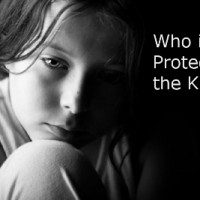Helping child abuse victims starts with 'first responders'
- Details
- Published on Thursday, 24 April 2014 12:44
- Written by Paul Gordon
Last in a series
Child abuse, said Clete Winkelmann, is one of those things that make people want to cover their eyes and run away.
"We don't do that," said Winkelmann, CEO of Children's Home in Peoria. "We run into the situation. We are basically the first responders in child abuse cases. We get as much training and guidance as the police do in responding to these cases because we need to."
Winkelmann was referring child welfare workers at his agency as well as at others agencies in central Illinois, statewide and basically throughout the country. Often for the child welfare worker, being called into a child abuse or neglect case comes after the situation has become its most volatile and it can be dangerous.
But child welfare workers don't carry weapons to diffuse such a situation.
"Instead of weapons we carry a big heart. In the end, that's the most important thing of all," said Winkelmann.
In this final installment of The Peorian's series on child abuse and neglect called "Who Is Protecting the Kids?" we look into some of the largest agencies in central Illinois. We didn't attempt to interview all of them but those we did, we believe, represent a good sampling for the services available in the region to victims of abuse and neglect.
More important, it tells of the type of people those victims will encounter; the people who will use the resources available to them to get those victims out of harm's way and work with them so they can recover, get help and, it is hoped, be reunited with loved ones.
The Children's Home
The Children's Home has changed through the decades, nearly 150 years after it was founded. But its core mission, caring for the children in the community, has never wavered.
The mission statement is clear: Giving children a childhood and future by protecting them, teaching them and healing the, and by building strong communities and loving families.
Its stated vision is concise: A healthy community where families and children come first.
Safety comes first for the children but also for the caseworkers, Winkelmann said. When police are called because of suspected child abuse, a caseworker is brought in, as well, whether from the state Department of Children and Family Services, from the Children's Home or another agency. Not only are the situation volatile, but the locations sometimes are less than desirable for one reason: Most of these cases involve people of poverty. These are not Peoria's most affluent neighborhoods.
"Everyone goes through TCI (Therapeutic Crisis Intervention) training to learn ways of controlling behaviors while deescalating volatile situations. Sometimes that becomes necessary just to get a child out of harm's way," he said.
That, he said, is just the start of the job The Children's Home will do with each child it comes in contact with. Because the goal of the state and every agency it contracts with is to keep the family together from the start or return the child to his parents, the whole family comes under the treatment of the agency.
"We are no longer just treating the child that shows up on our doorstep, so to speak. We are reaching far deeper into the family to learn what we can about the situation that brought that child to us to begin with. Then we try to help fix it, or else the kids would be right back here again in no time," Winkelmann said.
It's important to note that most of the children under the care of Children's Home particularly those in foster care, are wards of the state while their abuse or neglect case wends its way through the juvenile court system. There are currently about 15,000 children under the care of the state, which is far fewer than 20 years ago when agency were quicker to remove a child from a suspected abusive situation. Said Winkelmann, "In the 90s we removed too many kids from their homes. We did it when we saw the smallest of risk there could be harm and we learned that can cause just as much if not more damage," he said.
But removal from danger still is very much a part of what the Children's Home does. It has foster care services among the many child care programs in its stable. It has six locations where 400-plus employees provide for a monthly average of 1,100 children.
Only 150 of those children, however, are in foster care. Besides foster care, Children's Home offers behavioral health services. Many of the children have behavior problems and mental health issues that prevent them from being home or put into foster care. These children live at Youth Farm in the western part of Peoria County, an area that Winkelmann described as "serene, with peaceful open space that is much better for helping them to heal."
The Youth Farm has a capacity of 50 beds, of which 45 are dedicated to children sent by DCFS. "We need more capacity than that, but neither we nor the state can afford it. It is an expensive level of care. Our goal there is to get them stabilized to the point that can be moved into foster care," he said.
Children's Home also has group homes for children who cannot be put into foster care or until foster care can be found. Some are children too old for the foster care that is available. Nonetheless, Winkelmann said, they are well cared for and supervised and receive treatment toward helping them heal from the trauma they've endured.
Children's Home provides educational services through Kiefer School so the children don't fall behind and also now offer The Academy for Autism.
"We strive to keep up the quality of care for these children, which includes health assessments and crisis intervention, with family preservation the goal. Like other agencies, the goal is to find permanency within 18 months because we don't want these kids to linger in the system," Winkelmann said.
"But we do much more than work with kids who are abuse or neglect victims. One thing we're trying to do is work is closer unison with healthcare organizations to try and bridge the gap between physical and behavioral health. If you have someone with chronic mental health issues I guarantee he or she will have physical health problems, also," Winkelmann said.
The Center for Prevention of Abuse
When people think about the Center for Prevention of Abuse, the first thought that normally comes to mind is spousal abuse, that this is the place women go to be protected from abusive husbands or boyfriends.
After all, it was founded in 1975 as a rape crisis center and from 1978 to 1993 it was called Tri-County WomenStrength. The change to its current name came because in the 15 years in between, it came to be much more.
As Martha Herm, the center's executive director said, nobody ̶ women, men or children ̶ is immune to the effects of abuse.
Indeed, the mission of the center is to the point: To help all people to live free from violence and abuse.
Programming for children began in 1983 and has expanded through the years to include presentations aimed at preventing abuse, including teaching children through age 12 or 13 rules to protect themselves from unwanted touches. There are also programs that aim to prevent bullying, a sexual assault prevention programfor high school students and programs that are gender specific.
There are several programs, as well, for teachers and school staff on emotional teaching techniques, address bullying in schools and mandatory reporting of abuse.
In addition, The Center for Prevention of Abuse is one of only 12 centers in Illinois to offer Safe From the Start programs for children age birth to 5 who have seen or experienced any type of violence.
Herm said when a mother has been physically abused by her husband, one can bet the children in the family witnesses or heard it happen. "If a parent is being abused, there is a two-third likelihood the child or children or being abused. And even if the child isn't being abused in a domestic violence situation, they are affected by it. We have to try and make them understand it is not their fault," Herm said.
"Sometimes the child is made to be the scapegoat by the abuser. That child needs to understand they are not and we have treatment to help them, treatment that provides nurturing and loving."
Herm acknowledged domestic violence used to be all about the wife or mother. "It took a lot of time and research before we figured out that the kids get it. They know about it. They are affected," she said. "Research is even showing that abuse a pregnant woman goes through affects the development of the child. That is significant because domestic violence goes way up during pregnancy."
Programming at the Center for Prevention of Abuse approaches treatment of abuse from a family-centered standpoint "because we know the violence, the abuse, is not happening in a vaccum. It affects the whole family. Not only that, there is a thousand times more likelihood that a child of abuse will grow up to be an abuser or an adult victim. We are working to break that cycle."
Very little of the casework her agency does is court ordered, but Herm said the agency's reputation and quality of care results in referrals from police, churches and other social service agencies. "We know the child of abuse or domestic violence needs immediate help. We are ready to give that help," she said.
The Center for Prevention of Abuse remains the region's top agency to help victims of sexual assault, regardless of the age of the victim.
Herm said teaching children to prevent it is key in many situations, but teens and adults also must be aware of things they can do to be less vulnerable.
The center also strives to prevent elder abuse, which is a problem Herm said doesn't get the attention it needs. As with preventing child abuse, everybody needs to be aware of potential elder abuse situations and report it if they see or suspect it.
The Center for Prevention of Abuse can be visited at www.centerforpreventionofabuse.org. In a crisis situation the center can be reached at (800) 559-7233.
The Center for Youth & Family Solutions
When the Religious Freedom Act was adopted in June 2011, an interesting scenario developed. For decades the state had relied upon faith-based charities such as Catholic Charities for foster care and adoption services for victims of child abuse and neglect.
That became a problem for those faith-based organizations opposed to same-sex marriages or couples being allowed to adopt and the state's hands were tied; it could not discriminate against same-sex, civil union couples.
Rather than letting the 1,000-plus children under the care of Catholic Charities fall through the cracks, a group of its employees and directors formed The Center for Youth & Family Solutions, filing the requisite paperwork to ensure a continuity of care for the children. They hired the employees of Catholic Charities and picked up leases.
"These kids already had gone through some pretty heavy trauma. We didn't want any disruption in the care they were getting or in the efforts to find them permanency," said Tricia Fox, CEO of the Center for Youth & Family Solutions.
Added Anthony Riordan, chief operating officer, "It has been proven that if a child loses his or her caseworker, the success rate of getting the child back home falls from 75 percent to 17 percent. We were determined not to let that happen."
Indeed, CYFS faced and conquered big challenges to get here. But it has not, Fox and Riordan agreed, lost sight of the challenges its client children face every day. "We made the transition as seamless as we could for the clients. But it wasn't easy," Fox said. "It required quite an amount of pure perseverance. It took time. We had to get banking, take over $24 million worth of state contracts, redo other contracts..."
But it got done.
The agency's rocky start did not thwart its mission, however. It remains solid today: "The Center for Youth and Family Solutions engages and serves children and families in need with dignity, compassion, and respect by building upon individual and community strengths to resolve life challenges together."
That mission, the agency states on its website, www.cyfsolutions.org, reflects the belief in the "enduring strength, creativity, and perseverance of the human and community spirit to respond to and resolve life challenges."
What helped matters for CYFS is that the leadership and staff that moved over from the Peoria Diocese already had a proven track record, a reputation for getting done what needed to be done, said Riordan.
"The state (Department of Children and Family Services) knew we'd have the same administration, the same caseworkers and the same drive. This field is driven by performance-based results. That's the way it should be. Just because you care isn't good enough. You have to do the job well and we do," he said.
Fox said the state uses a complicated formula to measure the success of agencies, to see which ones performance best under all types of circumstances. "Our rating was solid and that, more than anything, is why the state helped us get this done," she said.
The services CYFS offers include adoption services, comprehensive behavioral health counseling, youth and family outreach, crisis pregnancy counseling, Intact Family Intervention, foster care, Guardian Angel Residential Program for youth.
It also is central Illinois' leading agency in dealing with runaways. That's a program, Riordan said, that could easily have fallen through the cracks because no other agency seemed ready or willing to step up and take it over. "We've been doing it for a long time and we have a 98 percent success rate and returning runaways to their families rather than being removed from the home," he said.
Just as important, Fox said, are the behavioral counseling CYFS and other groups such as Children's Home perform. "Some of these services would not have been picked up because of costs. The state has cut mental health services so drastically through the years somebody has to pick up the slack," she said.
Riordan said in many communities where CYFS goes, "We are now the only game in town."
One of the statistics CYFS touts is the 55 percent success rate in reunifying foster children with their natural parents. Reunification, Fox said, is something all child welfare agencies strive to achieve. "It's not just about getting kids that have been removed from their families into foster care and through childhood. Even in cases that end in adoption, we focus on open adoptions because these children, especially the older ones, know who their relative are and usually some form of communication continues," she said.
Added Riordan, "To act like that bond between the family and the child doesn't exist beyond adoption is counterproductive. We have to deal with it. Usually, it's the child who ends up maintaining contact."
Fox said the ideal foster care situation is to find a foster family where the child can stay at the same school and community and to maintain relationships with family. In fact, she said, a relative is usually the best option as a foster parent. "Rarely is it believed that starting over someplace complete different is the best option," she said.
With runaways, the first thing CYFS does when called in is to do a needs assessment of the child to determine if there is a risk to returning them home, Riordan said. Often, he added, the reason the runaway gives for leaving home triggers the response CYFS taken. "Typically, running away is a symptom of other dynamics going on in the family. That does not mean, though, that there is any risk to the child. That is what we have to discern and that isn't always easy. There could be a lot of moving targets to assess," he said.
It's a responsibility that takes special training as well as a big heart to take on, Fox said. "We have to make big decisions that affect a lot of lives."

















































